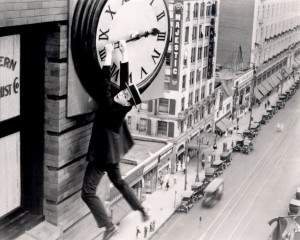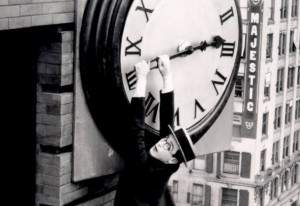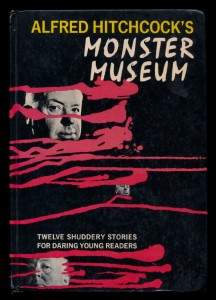The best Christmas present I ever got
December 24, 2023 by Thomas Wictor
Later in this post I’ll describe the best Christmas present anyone has ever given me. A simple gift, it altered the course of my life. This post will (hopefully) show the impact that the present had on me.
Christmas was always a major affair in my family, due to my father’s love of the holiday. He began playing Christmas carols earlier and earlier each year, until once in the early eighties he began in August. Usually he’d put up the tree the day after Thanksgiving, but in 1974 he did so in September. Since he took it down in February, that means the tree was was in our living room for almost five months.
He kept a small Christmas tree on his desk all year round.
It’s about one foot (thirty centimeters) tall. My father was inspired by the comedian Harold Lloyd, who did the same thing.
Lloyd is one of my heroes. I could write about him all night. One reason that I admire him is that although he was stuntman, he was missing the thumb and index finger of his right hand, an injury from an explosive device. He wore a rubber prosthetic glove during filming.
If you haven’t seen any of his films, give them a try. You won’t be disappointed.
Tim’s Christmas tree for this year.
We wished each other a Merry Christmas earlier and retired to our respective houses. It’s the second non-celebration of Christmas we’ve experienced. Maybe someday we’ll do a little more. Who knows? No door has been closed on anything.
Too many of us use Christmas as the occasion for buying ourselves gifts that we think will make up for unhappy childhoods. A person who did so was one of the greatest rock singers ever, Layne Staley of Alice in Chains.
Not only was his voice powerful, he sang incredibly long phrases, and it wasn’t possible to tell the difference between live and studio recordings. But Alice in Chains was arbitrarily disdained by clowns known as critics, and Staley turned to drugs. He died of a heroin and cocaine overdose on April 5, 2002, at the age of thirty-four.
In his apartment there were toys all over the floor, trucks and action figures. Staley had discussed buying himself toys and playing with them. Of course they did nothing. Giving yourself presents like that—especially ones from the past—bring no happiness.
I know, because from 1993 until 1999, I bought thousands of plastic model kits, aircraft from World War I.
Such model kits from my childhood are sought-after collectors’ items. But they didn’t bring me joy. It was just a compulsive need to try and change events from long ago. Now I have a whole closet full of models.
Model kits. Not a closet full of models.
No idea if a closet full of models would make up for an unhappy childhood, but I’m not opposed to researching the proposition.
I’ll never build the model kits because I’ve lost too much of my eyesight. Before I move to Texas, I’ll find a deserving collector and give him the bargain of a lifetime. Just because I can.
The best Christmas present I ever got
It was Christmas of 1973. We lived in Tyler, Texas, and I was eleven. I still have it. Here it is.
It contains some of the most spectacular short stories ever written. Each one is a masterpiece. These are the standouts.
“Slime,” by Joseph Payne Brennan. A large, gelatinous life form is hurled by a volcanic eruption from the bottom of the ocean to the surface. This thing is as old as the earth itself and has fed on whales, giant squid, and sharks. It knows no fear. Flung ashore, it quickly adapts to terrestrial life and begins hunting. Its only motivation is hunger. Having no mouth, it simply absorbs what it eats. The fact that it has no shape allows it to move at tremendous speed, like a massive tortilla skimming over the land. No weapon is effective because any wound made is simply filled in. How will they stop it?
“The Man Who Sold Rope to the Gnoles,” by Idris Seabright. A rope salesman named Mortensen decides to try and sell cordage to the gnoles, creatures “a little like a Jerusalem artichoke made of rubber,” with “small red eyes which are faceted in the same way that gemstones are.” They have a bad reputation—due likely to the dungeons in the cellar of their house, “in architecture a blend of Victorian Gothic and Swiss chalet.” Mortensen ignores all warning signs, determined to make his sale.
“The Microscopic Giants,” by Paul Ernest. Utterly exceptional. During World War I, an American copper-mining company digs down 40,000 feet (12,192 meters) around Lake Superior. They find tiny human footprints—shod footprints—in the bedrock. The workers begin refusing to enter the shaft, and then the foreman and his assistant discover that humans had long ago bifurcated. One group stayed on the surface, and the other went deep underground. Due to the pressures involved, the underground humans compressed. They were only eighteen inches (46 centimeters) tall, but now they weighed several tons. Being so dense, they could move directly through solid rock as though it were fog. And they weren’t happy to see their relatives from the surface.
And my favorite, “The Desrick on Yandro,” by Manly Wade Wellman. A bluegrass guitarist in Appalachia is invited to the home of a wealthy patron to sing. One of his tunes is about a house—a desrick—on Yandro’s hill. After he finishes, the singer is approached by the egomaniac grandson of the Yandro in the song. He bullies the singer into taking him to Yandro’s hill to see if there’s indeed a desrick, and if the area might be worth buying. Yandro the grandson didn’t listen to the lyrics of the song, which are about how the grandfather seduced a local maiden and got her to show him where the gold in the mountains was. Then he abandoned her. The girl was a witch, and after she built the desrick, she sat in it and sang, waiting for her lover to return to pay his debts.
My mother gave me that book. After reading it once, I was able to quote passages from every story. I still can.
Mrs. Kovacs began to remove the platter of raw beef. Mr. Kovacs reached out and took one of the remaining chunks and bit into it with teeth that, when he opened his mouth wide, were startlingly long and white and, from the way the meat tore, sharp.
—”The Young One,” by Jerome Bixby
Each writer made each short story just about perfect. The book has been with me for forty-one years. During the decades that I struggled to break the code, I’d pick it up and think How did they do it? Every now and then I’d reread the book from cover to cover, looking for the key.
My mother knew that I’d find it someday.
Thanks, Mom. Merry Christmas.
This article viewed 612 times.








